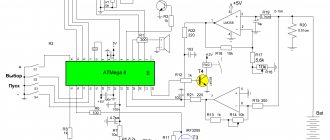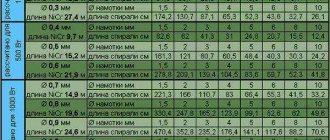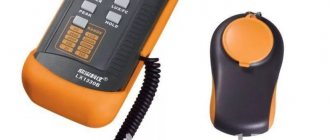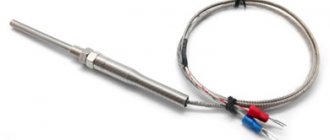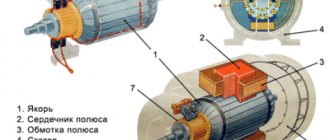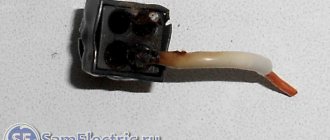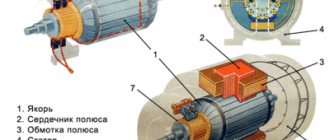Connecting an RCD (residual current device) is a generally accepted measure in world practice to increase the electrical safety of consumers. The number of lives saved by RCDs runs into the millions, and the use of RCDs in the power supply networks of apartment and private residential buildings, residential areas and industrial facilities prevents billions of dollars in damage from fires and accidents.
But Galen’s rule: “Everything is poison and everything is medicine” is true not only in medicine. Outwardly simple, an RCD, if used thoughtlessly or carelessly, can not only prevent nothing, but also become a source of trouble. By analogy: someone built Kizhi with one ax, someone can build some kind of hut with it, but someone cannot even be given an ax in their hands, they will chop off something for themselves. So let's get to know the RCD in more detail.
First of all
Any serious conversation about electricity will inevitably touch on electrical safety rules, and for good reason. Electric current does not carry visible signs of danger; its effect on the human body develops instantly, and the consequences can be long-lasting and severe.
But in this case we will not talk about the general rules for electrical installation work, which are already well known, but about something else: the RCD fits very poorly into the old Soviet TN-C power supply system, in which the protective conductor is combined with the neutral. For a long time it was unclear whether it fit in at all.
All editions of the PUE clearly require: the installation of switching devices in the protective conductor circuits is prohibited. The wording and numbering of paragraphs changed from edition to edition, but the essence is clear, as they say, even to the marabou bird. But what about recommendations for the use of residual current devices? Are they switching devices, and at the same time are included in the gap of both phase and ZERO, which is also a protective conductor?
Finally, in the 7th current edition of the PUE (PUE-7A; Rules for the construction of electrical installations (PUE), 7th edition, with additions and changes, M. 2012), clause 7.1.80 still dotted the i’s: “It is not allowed to use RCDs responding to differential current in four-wire three-phase circuits (TN-C system).” This tightening was caused, contrary to previous recommendations, by recorded cases of electrical injuries WHEN THE RCD was activated.
Electric shock due to incorrect connection of the RCD
Let’s explain with an example: The housewife was doing the laundry; the heating element in the machine broke through on the housing, as shown in the figure by the yellow arrow. Since 220 V current is distributed along the entire length of the heating element, there will be something around 50 V on the body.
Here the following factor comes into force: the electrical resistance of the human body, like any ionic conductor, depends on the applied voltage. As it increases, human resistance decreases, and vice versa. For example, the PTB provides an absolutely justified calculated value of 1000 Ohms (1 kOhm), with sweaty, steamed skin or in a state of intoxication. But then at 12 V the current should be 12 mA, and this is more than the non-releasing (convulsive) current of 10 mA. Has anyone ever been hit by 12 V? Even completely drunk in a jacuzzi with sea water? On the contrary, according to the same PTB, 12 V is an absolutely safe voltage.
At 50-60 V on wet, steamed skin, the current will not exceed 7-8 mA. This is a strong, painful blow, but the current is less than convulsive. You may need treatment for the consequences, but it won’t go as far as resuscitation with defibrillation.
Now let’s “defend ourselves” against the RCD, without understanding the essence of the matter. Its contacts do not open instantly, but within 0.02 s (20 ms), and not absolutely synchronously. With a probability of 0.5, the ZERO contact will open first. Then, figuratively speaking, the potential reservoir of the heating element at the speed of light (literally) will be filled to 220 V along its entire length, and on the body there will be 220 V, and a current of 220 mA will pass through the body (red arrow in the figure). Less than 20 ms, but 220 mA is more than two instantly killing 100 mA values.
So, is it impossible to install RCDs in old houses? It’s still possible, but carefully, with a full understanding of the matter. You need to choose the right RCD and connect it correctly. How? This will be discussed further in the relevant sections.
Types of RCD
When planning the internal power supply of various objects, attention is paid to the criteria for differential current and its type. According to the operating requirements of the devices, the following types of residual current devices are distinguished:
- AC - reaction to alternating current, which appears gradually or instantly;
- A – reaction to alternating or pulsating current, smoothly or unexpectedly and quickly appearing;
- B – reaction to alternating, direct or rectified currents;
- S – selective, maintaining the shutdown period;
- G – similar to the previous type with a minimum amount of time.
According to the method of technical execution, a distinction is made between devices that are functionally dependent and those that are not dependent on the supply voltage.
RCD - what and how
RCDs in electrical engineering appeared simultaneously with the first power lines in the form of relay protection. The purpose of all RCDs remains unchanged to this day: to turn off the power supply in the event of an emergency. The vast majority of RCDs (and all household RCDs) use leakage current as an indicator of an accident - when it increases above a given limit, the RCD trips and opens the power supply circuit.
Then RCDs began to be used to protect individual electrical installations from breakdown and fire. For the time being, RCDs remained “fire-proof”; they responded to a current that prevented the ignition of an arc between the wires, less than 1 A. “Fire” RCDs are produced and used to this day.
Video: what is an RCD?
UZO-E (capacitive)
With the development of semiconductor electronics, attempts began to create household RCDs designed to protect people from electric shock. They worked on the principle of a capacitive relay responding to a reactive (capacitive) bias current; in this case, the person acts as an antenna. The well-known phase indicator with neon is built on the same principle.
RCD-Es have exceptionally high sensitivity (fractions of µA), can be made to operate almost instantly and are absolutely indifferent to grounding: a child standing on an insulating floor and reaching with his finger to the phase in the socket will not feel anything, but the RCD-E will “smell” him and will turn off the voltage until he removes his finger.
But RCD-E have a fundamental drawback: in them, the flow of leakage current electrons (conduction current) is a consequence of the occurrence of an electromagnetic field, and not its cause, therefore they are extremely sensitive to interference. There is no theoretical possibility of “teaching” UZO-E to distinguish a little scoundrel who picked up an “interesting thing” from a tram that sparkled on the street. Therefore, RCD-E is used only occasionally to protect special equipment, combining its direct responsibilities with touch indication.
UZO-D (differential)
By “turning” the RCD-E “the other way around,” we were able to find the operating principle of the “smart” RCD: you need to go directly from the primary flow of electrons, and the leakage is determined by the imbalance (difference) of total currents in the POWER conductors. If exactly the same amount flows away from the consumer as went to him, everything is in order. If there is an imbalance, there is a leak somewhere, you need to turn it off.
The difference in Latin is differentia, in English difference, which is why such RCDs were called differential, RCD-D. In a single-phase network, it is enough to compare the magnitudes (modules) of currents in the phase wire and neutral, and when connecting an RCD in a three-phase network, the total current vectors of all three phases and the neutral. An essential feature of the RCD-D is that in any power supply circuit, the protective and other conductors that do not transmit power to the consumer must pass by the RCD, otherwise false alarms are inevitable.
It took quite a long time to create household RCD-Ds. Firstly, it was necessary to accurately determine the amount of unbalance current that is safe for humans with an exposure time equal to the response time of the RCD. RCDs-D, configured for an imperceptible or smaller non-releasing current, turned out to be large, complex, expensive, and they “caught” interference only slightly worse than the RCD-E.
Secondly, it was necessary to develop highly coercive ferromagnetic materials for differential transformers, see below. Radio ferrite was not suitable at all, it did not maintain working induction, and RCD-D with transformers on iron turned out to be too slow: the own time constant of even a small iron transformer can reach 0.5-1 s.
UZO-DM
Operating principle of differential electromechanical RCD
By the 80s, the research was successfully completed: the current, based on experiments on volunteers, was chosen to be 30 mA, and high-speed ferrite differential transformers with a saturation induction of 0.5 Tesla (Tesla) made it possible to remove power from the secondary winding sufficient to directly drive the breaker electromagnet. Differential electromechanical RCD-DMs have appeared in everyday life. Currently, this is the most common type of household RCD, so DM is omitted, and they say or write simply RCD.
A differential electromechanical RCD works like this, see figure on the right:
- Without leakage, currents in the phase and neutral conductors, according to the gimlet rule known from school physics, excite equal but oppositely directed magnetic fluxes F1 and F2 in the ferrite ring, which suppress each other. The resulting magnetic flux in the core is Ф = 0, and the emf of the secondary winding wound on ferrite is zero.
- When a leak occurs (say, when a person touches the body of a faulty electrical installation, as in the figure), one of the currents becomes larger, a magnetic flux appears in the ferrite, inducing an EMF in the secondary winding.
- Under the current from the secondary winding, the electromagnet pulls the latch of the contactor of the breaker, and the contacts open under the action of the spring.
- Using the “Test” button, artificially creating an imbalance of currents in the RCD, its performance is checked; a flag or a self-latching button is used to turn it on again after triggering.
Appearance of three-phase and single-phase RCDs
The appearance with explanations of the symbols on the housing of a three-phase and single-phase RCD is shown in the figure above.
Note:
Using the “Test” button, the RCD is supposed to be checked monthly and every time it is turned on again.
An electromechanical RCD only protects against leakage, but its simplicity and “oak” reliability made it possible to combine an RCD and a current circuit breaker in one housing. To do this, it was only necessary to make the breaker lock rod double and insert it into the current and RCD electromagnets. This is how a differential automatic machine appeared, providing complete consumer protection.
Appearance of the difavtomat (left) and RCD (right)
However, a difavtomat is not an RCD or an automatic machine separately, this should be clearly remembered. External differences (power lever, instead of a flag or a restart button), as in the picture, are only appearances. An important difference between an RCD and a differential circuit breaker is reflected when installing an RCD in power supply systems without protective grounding (TN-C, autonomous power supply), see below the section on connecting an RCD without ground.
Important:
A separate RCD is designed to protect against leakage ONLY. Its rated current shows to what value the RCD remains operational. RCDs with ratings of 6.3 and 160 A with the same unbalance of 30 mA provide the same degree of protection. In difavtomats, the cut-off current of the machine is always less than the rated current of the RCD, so that the RCD does not burn out when the network is overloaded.
UZO-DE
In this case, the “E” does not stand for capacitance, but for electronics. UZO-DE are designed to be built directly into an outlet or electrical installation. The current difference in them is detected by a semiconductor magnetically sensitive sensor (Hall sensor or magnetodiode), its signal is processed by a microprocessor, and the circuit is opened by a thyristor. UZO-DE, in addition to compactness, has the following advantages:
- High sensitivity, comparable to UZO-E, combined with noise immunity of UZO-DM.
- As a consequence of high sensitivity, the ability to respond to displacement current, i.e., the RCD-DE is proactive, will turn off the voltage before it hits someone, regardless of the presence of grounding.
- High performance: to “stimulate” the RCD-DM, at least one half-cycle of 50 Hz is required, i.e. 20 ms, and at least one dangerous half-wave must pass through the body for the RCD-DM to work. RCD-DE is capable of triggering at a voltage of the “breakdown” half-wave of 6-30 V and cutting it off in the bud.
The disadvantages of the RCD-DE are, first of all, high cost, its own energy consumption (negligible, but if the network voltage drops, the RCD-DE may not work) and the tendency to failure - it is electronic after all. Abroad, chip sockets became widespread back in the 80s; in some countries their use in children's rooms and institutions is required by law.
In our country, UZO-DE is still little known, but in vain. The bickering between mom and dad about the cost of a “foolproof” outlet is not comparable to the cost of a child’s life, even if an incorrigible mischief and troublemaker is rampaging through the apartment.
UZO-D indices
Depending on the device and purpose, main and additional indices may be added to the name of the RCD. Using the indexes, you can make a preliminary selection of the RCD for the apartment. Main indices:
- AC - triggered by an imbalance in the alternating current component. They are carried out, as a rule, as fire protection, for an unbalance of 100 mA, because cannot protect against short-term pulse leakage. Inexpensive and very reliable.
- A - react to imbalance of both alternating and pulsating currents. The main design is 30 mA imbalance protection. False alarms/failures are possible in the TN-C system in any case, and in the TN-CS with poor grounding and/or the presence of powerful consumers with significant own reactivity and/or switching power supplies (UPS): washing machine, air conditioner, hob, electric oven, food processor; to a lesser extent - dishwasher, computer, home theater.
- B - react to leakage current of any kind. These are either industrial RCDs of the “fire” type for 100 mA imbalance, or built-in RCDs-DE.
Additional indices give an idea of the additional functionality of the RCD:
- S – time-selective response, it is adjustable within 0.005-1 s. The main area of application is in the power supply of facilities powered by two beams (feeders) with an automatic transfer switch (ATS). Adjustment of the response time is necessary so that when the main beam disappears, the ATS has time to operate. In everyday life they are sometimes used in elite cottage communities or mansions. All selective RCDs are fire protection, for an unbalance of 100 mA, and require the installation after themselves of protective 30 mA RCDs for a current of a lower stage, see below.
- G – high-speed and ultra-fast RCDs with a response time of 0.005 s or less. They are used in children's, educational, medical institutions and in other cases when “breakthrough” of at least one damaging half-wave is unacceptable. Exclusively electronic.
Note: household RCDs are most often not indexed, but differ in design and unbalance current: electromechanical 100 mA - AC, they are 30 mA - A, built-in electronic - B.
PATTERN
A type of RCD almost unknown to non-specialists is non-differential, triggered by current in the protective conductor (P, PE). They are used in industry, in military equipment and in other cases when the consumer creates strong interference and/or has its own reactivity that can “confuse” even an RCD-DM. They can be either electromechanical or electronic. Sensitivity and performance for domestic conditions are unsatisfactory. A high quality maintained grounding is a must.
How the RCD works and how it works
The RCD includes a differential transformer, three magnetic coils, a relay, and a test button. The primary (1) coil receives phase current from the transformer. Zero arrives at the secondary (2) coil. Magnetic fields arise at the input and output. By directing the coils towards each other, the magnetic fields are equally compensated. The third (3) coil is inactive, the relay is in a resting state. This is the situation in normal mode (resting state).
device diagram
When a current leak occurs, the balance is lost. As soon as the leakage current reaches a predetermined setting, the third coil begins to operate. The relay is activated. There is an almost instantaneous opening of the contacts. Thus, the RCD reacts to leakage currents and prevents dangerous situations.
It is important that devices are grounded. This is required by all methods of protection against electric current. Indirect or direct contact with an ungrounded/ungrounded housing and live parts of the device may result in electric shock!
Video about how the RCD works:
RCD selection
To choose the right RCD, the index is not enough. You also need to find out the following:
- Should I buy separately an RCD with an automatic device or a difavtomatic one?
- Select or calculate the cutoff value for extra current (overload);
- Determine the rated (operating) current of the RCD;
- Determine the required leakage current - 30 or 100 mA;
- If it turns out that for general protection you need a 100 mA “fire” RCD, determine how many, where and what kind of secondary “life” 30 mA RCDs are required.
Separately or together?
In an apartment with TN-C wiring, you can forget about the automatic switch: the PUE prohibits it, but if you ignore it, the electricity itself will soon remind you. In the TN-CS system, the difavtomat will cost less than two separate devices if reconstruction of the wiring is planned. If the current circuit breaker is already installed, then a separate RCD matched with it in terms of operating current will be cheaper. Writings on the topic: RCD is incompatible with a conventional machine gun - amateurish nonsense.
What overload should I expect?
The cutoff current of the machine (extracts) is equal to the maximum permissible current consumption of the apartment (house), multiplied by 1.25 and added to the nearest higher value from the standard series of currents 1, 2, 3, 4, 5, 6.3, 8, 10, 13, 16 , 20, 25, 32, 35, 40, 50, 63, 80, 100, 125, 160, 250, 400, 630, 1000, 1600, 2500, 4000 and 6300 A.
The maximum current consumption of the apartment must be recorded in its registration certificate. If not, you can find out from the organization operating the building (obliged to report by law). In old houses and new budget ones, the maximum permissible current is usually 16 A; in new regular (family) - 25 A, in business class - 32 or 50 A, and in suites 63 or 100 A.
For private households, the maximum current is calculated according to the power consumption limit from the technical passport (the authorities will not let you register it) at the rate of 5 A per kilowatt, with a coefficient of 1.25 and addition to the nearest higher standard value. If the data sheet directly states the value of the maximum current consumption, it is used as the basis for the calculation. Conscientious designers directly indicate the cut-off current of the main circuit breaker on the wiring plan, so there is no need to count.
RCD current
The rated (operating) current of the RCD is taken one step higher than the cut-off current. If a difavtomat is installed, it is selected according to the CUT-OFF CURRENT, and the current rating of the RCD is built into it structurally.
Video: RCD or difavtomat?
Leakage current and general protection circuit
For an apartment with TN-CS wiring, it would not be a mistake to take an RCD for 30 mA unbalance without further thought. A separate section will be devoted to the TN-C apartment system, but for private houses it is impossible to immediately give clear and definitive recommendations.
According to clause 7.1.83 of the PUE, the operating (natural) leakage current should not exceed 1/3 of the RCD unbalance current. But in a house with an electric heated floor in the hallway, courtyard lighting and electric heating of the garage in winter, the operating leakage current can reach 20-25 mA with a living area of 60 and 300 square meters.
In general, if there is no greenhouse with electrically heated soil, a heated water well, and the yard is illuminated by housekeepers, at the input after the meter it is often enough to install a fire RCD with a rated current one step higher than the cut-off current of the machine, and for each group of consumers - a protective RCD with the same rated current. But an accurate calculation can only be made by a specialist based on the results of electrical measurements of finished wiring.
Calculation examples
Let's look at how to calculate an RCD using examples for different cases.
The first is a new apartment with TN-CS wiring ; According to the data sheet, the power consumption limit is 6 kW (30 A) . We check the machine - it is at 40 A, everything is OK. We take the RCD a step or two higher in rated current - 50 or 63 A, it doesn’t matter - and for an unbalance current of 30 mA. We don’t think about the leakage current: the builders must provide it within normal limits, but if not, let them fix it themselves for free. However, contractors do not allow such mistakes - they know what replacing electrical wiring under warranty smells like.
Second. Khrushchevka, 16 A plugs. We install a 3 kW washing machine; current consumption is about 15 A. To protect it (and protect against it) you need an RCD with a rating of 20 or 25 A for 30 mA imbalance, but 20 A RCDs are rarely on sale. We take a 25 A RCD, but in any case, it is MANDATORY to remove the plugs and install a 32 A machine instead, otherwise the situation described at the beginning is possible. If the wiring clearly cannot withstand a short-term surge of 32 A, nothing can be done, you need to change it.
In any case, you need to submit an application to the energy service to replace the meter and reconstruct the electrical wiring, with or without replacement. This procedure is not very complicated and troublesome, and a new meter with an indication of the wiring status will serve you well in the future, see the section on errors and malfunctions. And the RCD registered during reconstruction will then allow you to call electricians for free for measurements, which is also very good for the future.
Third. A cottage with a consumption limit of 10 kW, which gives 50 A. The total leakage according to the measurement results is 22 mA, with the house giving 2 mA, the garage - 7, and the yard - 13. We set the general difavtomat to 63 A cutoff and 100 mA imbalance, house with the garage we power it separately through an RCD for 80 A nominal and 30 mA unbalance. In this case, it is better to leave the yard without its own RCD, but take the lamps for it in waterproof cases with a grounding terminal (industrial type), and connect their grounds directly to the ground loop, this will be more reliable.
Connecting an RCD in an apartment
Typical circuit diagram for switching on an RCD in an apartment
A typical diagram for connecting an RCD in an apartment is shown in the figure. It can be seen that the general RCD is switched on as close as possible to the input, but after the meter and the main (access) machine. The inset also shows that in the TN-C system a general RCD cannot be turned on.
If separate RCDs are needed for groups of consumers, they are turned on immediately BEHIND the corresponding machines, highlighted in yellow in the figure. The rated current of secondary RCDs is taken a step or two higher than that of “your” machine: for VA-101-1/16 - 20 or 25 A; VA-101-1/32 – 40 or 50 A.
But this is in new houses, and in old ones, where protection is most needed: there is no land, the wiring is poor? Someone there promised to enlighten me on the subject of connecting an RCD without ground. That's right, that's exactly what it came to.
Main purpose of the device
Do you know how RCD stands for? Residual current device. Most people mistakenly believe that circuit breakers (commonly called automatic circuit breakers) and RCDs are one and the same.
It is important to understand here what is the difference, what does each of these devices protect and from what?
The circuit breakers protect the supply voltage network. For example, each room in your house is powered by a separate circuit breaker. If a short circuit or overload occurs in any electrical branch, the circuit breaker will turn off and thereby cut off the damaged section, saving the general network.
An RCD is installed in an apartment to protect people. The decoding itself speaks about this - “protective shutdown”, that is, the element protects a person from accidental electric shock.
How does he do this?
Our homes are now stuffed with a huge number of household appliances, and some electrical appliances are very powerful. At the same time, electrical wiring has a certain service life and over time there is a possibility of insulation failure, which will entail connecting the wiring to the ground. As a result, the current will begin to move not along a given path, but a leakage to the ground will occur; a person can become a conductor for this. Let's also look at this with an example.
Suppose that an insulation breakdown occurs in some electrical household appliance (kettle, dishwasher or washing machine, vacuum cleaner).
As a result, the body of the electrical appliance will have a certain potential. If you touch the body, you can get an electric shock. As you can see, in order to get an electrical injury, it is not necessary to climb into an outlet, everything is much more banal, which is why it is so important to protect yourself from such accidental touches.
Of course, if there is a grounding loop in the room and switching devices (sockets) with grounding are installed, they will save you from electrical injury. But sometimes the electrics in our apartments do not fully comply with the standards and rules. Agree, not everyone and not every room has sockets with a grounding contact, and we have no confidence at all in the quality and reliability of the grounding circuit.
Visually about the RCD in the video:
This means that you will have to protect yourself by installing RCDs in the distribution panels. As soon as a current leak appears, it turns off, thus saving human life.
An equally important purpose of the device is to protect houses from the possibility of fire and fire that arise when the wiring insulation is damaged.
RCD without ground
Method of connecting an RCD without protective grounding
Section 7.1.80, quoted at the beginning, does not exist in splendid isolation in the PUE. It is supplemented with points explaining how (well, there are no grounding loops in our houses, no!) to “shove” an RCD into the TN-C system. Their essence boils down to the following:
- It is unacceptable to install a general RCD or a circuit breaker in an apartment with TN-C wiring.
- Potentially dangerous consumers must be protected by separate RCDs.
- The protective conductors of sockets or socket groups intended for connecting such consumers must be connected to the INPUT zero terminal of the RCD in the shortest possible way, see the diagram on the right.
- Cascade activation of RCDs is allowed, provided that the upper ones (closest to the electrical input RCDs) are less sensitive than the terminal ones.
A smart person, but unfamiliar with the intricacies of electrodynamics (which, by the way, many certified power electricians are guilty of) may object: “Wait, what’s the problem? We install a common RCD, connect all PEs to its input zero - and you’re done, the protective conductor is not switched, we are grounded without a ground!” Yes, but not so.
The PE segment with the corresponding zero segment and the equivalent consumer resistance R form a loop encircling the magnetic circuit of the differential transformer, see the operating principle of the RCD-D. That is, a PARASITIVE winding appears on the magnetic circuit, loaded at R. Although R is small (48.4 Ohm/kW), on a sine wave of 50 Hz the influence of the parasitic winding can be neglected: the radiation wavelength is 6000 km.
We also exclude the electromagnetic field of the installation and the cord to it from consideration. The first is concentrated inside the device, otherwise it will not pass certification and will not go on sale. In a cord, the wires pass close to each other, and their field is concentrated between them, regardless of frequency, this is the so-called. T-wave.
But in the event of a breakdown on the body of the electrical installation or in the presence of interference in the network, a short powerful current pulse jumps through the parasitic loop. Depending on specific factors (which can only be accurately calculated by a specialist with experience in scientific work and on a powerful computer), two options are possible:
- “Anti-differential” effect: a surge of current in the parasitic winding compensates for the imbalance of currents in phase and zero, and the RCD will, as they say, peacefully sniffle into the pillow when a crooked firebrand is already hanging on the wires. The case is extremely rare, but extremely dangerous.
- A “super-differential” effect is also possible: the pickup increases the imbalance of currents, and the RCD trips without leakage, prompting the owner to think painfully: why does the RCD trip every now and then if everything is in order in the apartment?
The magnitude of both effects depends strongly on the size of the parasitic loop; This is where her openness and “antenna” come into play. With a PE length of up to half a meter, the effects are negligible, but already with a length of 2 m, the probability of failure of the RCD increases to 0.01%. According to the numbers, this is small, but according to statistics - 1 chance in 10,000. When it comes to human life, this is unacceptable a lot of. And if in an apartment without grounding there is a web of “protective” conductors, then why be surprised if the RCD “knocks out” when you turn on the charging of your mobile phone.
In an apartment with an increased fire hazard, it is permissible, with the obligatory presence of individual consumer RCDs connected according to the recommended circuit, to install a general FIRE RCD with a 100 mA imbalance and with a rated current one step higher than that of the protective ones, regardless of the cut-off current of the machine. In the example described above, for Khrushchev, you need to connect an RCD and an automatic machine, but not a automatic machine! When the machine is knocked out, the RCD must remain in operation, otherwise the likelihood of an accident increases sharply. Therefore, the RCD in terms of its rating must be taken two steps higher than the machine (63 A for the disassembled example), and in terms of unbalance - one step higher than the final 30 mA (100 mA). Once again: in automatic machines the rating of the RCD is made one step higher than the cut-off current, so they are not suitable for wiring without ground.
Connection principles
2 conductors are connected to the RCD. Through one, the current goes to the load, and with the help of the second it leaves the consumer through an external circuit. If a current leak occurs, there will be a difference between its input and output values. If the difference value exceeds the maximum permissible limit for the RCD, the machine is triggered, breaking the circuit.
RCDs are susceptible to the negative effects of short circuits and voltage surges. Therefore, additional machines should be used to protect them. Circuits with RCDs and automatic circuit breakers are used almost everywhere today. It is also advisable to supplement them with a voltage relay. The latter will protect electrical appliances from failure in the event of power surges.
The design of the device has a ring-shaped core with 2 windings. The current supplied to the load passes first through one winding. Flowing in the opposite direction, it passes through another winding.
According to the PUE, conductors must be connected to devices from top to bottom. This is due to the efficiency of the protective unit. When connected in the opposite direction, the effectiveness of the circuit breakers is significantly reduced.
RCDs with low ratings, intended for installation on individual lines, cannot be used for installation in a general network. This will lead to an increased risk of short circuits and leaks.
Well, it’s knocked out...
Why does the RCD trip? Not how, this has already been described, but why? And what to do if it works? If it's knocked out, does that mean something is wrong?
Right. You can’t just turn it on after it’s triggered until its cause is found and eliminated. And you can find where things are “wrong” yourself without any special knowledge, tools or equipment. An ordinary apartment electricity meter will be of great help in this, unless it is completely antique.
How to find the culprit?
First, turn off all the switches, remove everything from the sockets. In the evening, you will have to use a flashlight to do this; It is better to immediately attach a hook to the wall when installing next to the RCD and hang a cheap LED flashlight on it.
Next, we try to turn on the RCD. Has it turned on? We are looking for a “scoundrel” among consumers; how - a little lower. If not, you need to check the RCD and wiring.
We turn off the entrance or main apartment automatic machine. Doesn't turn on? The electrical mechanics of the RCD are to blame; needs to be sent in for repair. You can’t dig around yourself - the device is vital, and after repair it needs to be checked using special equipment.
It turned on, but when the voltage was applied, it went out again with empty wiring? In the RCD, there is either an internal imbalance of the differential transformer, or the “Test” button is stuck, or the wiring is faulty.
Indication of electrical wiring fault on the meter
We try to turn it on under voltage, looking at the meter. If the “Ground” indicator flashes at least for a moment (see figure), or it was previously noticed that it was winking, there is a leak in the wiring. Measurements need to be taken. If the RCD is installed in order to reconstruct the wiring and is registered with the energy service, you need to call municipal electricians, they are required to check. If the RCD is “self-made”, pay a specialized company. The service, however, is not expensive: modern equipment allows you to do it in 15 minutes. Find a leak in the wall with an accuracy of 10 cm.
But before you call the company, you need to open and inspect the sockets. Insect excrement provides excellent leakage from phase to ground.
The wiring does not inspire concern, they even turned it off section by section with automatic machines, but the RCD trips “on empty”? The fault is within it. Both imbalance and sticking of the “Dough” are most often caused not by condensation or intensive use, but by the same “cockroach poop”. In Rostov-on-Don, there was a case when in a perfectly well-kept apartment in the UZO a nest was discovered... of Turkestan earwigs, who knows how they got there. Hefty, with huge powerful cerci (pincers on the tail), terribly angry and biting. They did not show themselves in any way in the apartment.
Indication of consumer reactivity by an electric meter
The RCD trips when consumers are connected, but there are no signs of short circuit? We turn on everything, especially potentially dangerous ones (see the section on the classification of RCDs by index), try to turn on the RCD, again looking at the meter. This time, in addition to the “Earth”, it is possible that the “Reverse” indicator will glow; sometimes it is designated “Return”, next. rice. This indicates the presence of high reactance, capacitance or inductance in the circuit.
You need to look for a defective consumer in the reverse order; on its own, it may not reach the RCD before it triggers. Therefore, we turn on everything, then turn off the suspicious ones one by one, and try to turn them on. Has it finally turned on? This is what he is, “reverse”. For repairs, but not for electricians, but for “household appliances.”
In apartments with TN-CS wiring, it is possible that it is not possible to clearly determine the source of the RCD triggering. Then the likely cause is bad soil. While still maintaining protective properties, grounding no longer removes higher components of the interference spectrum, and the protective conductors act as an antenna, similar to a TN-C apartment with a common RCD. Most often, this phenomenon is observed during periods of greatest drying and freezing of the soil. So what to do? I am obliged to strain the building operator, let him bring the circuit up to standard.
About filters
One of the main sources of failures in the operation of RCDs is interference from household appliances, and an effective way to combat them is absorbing ferrite filters. Have you seen the “knobs” on computer cords? This is what they are. Ferrite rings for filters can be purchased at a radio store.
Homemade absorption ferrite filters
But for power ferrite absorbers, the magnetic permeability of ferrite and the saturation magnetic induction in it are of decisive importance. The first should be at least 4000, or better yet, 10,000, and the second should be at least 0.25 Tesla.
A filter on one ring (above in the figure) can be built into a “noisy” installation, if it is not under warranty, as close as possible to the network input. This work is for an experienced specialist, so the exact diagram is not given.
Several rings can simply be put on the power cord (in the figure below): from the point of view of electrodynamics, it doesn’t matter whether the conductor is wound around the magnetic core or vice versa. In order not to cut the proprietary molded cord, you need to buy a plug, a socket block and a piece of three-core cable. Ready-made power cords with ferrite noise absorbers are also sold, but these cost more than a homemade one assembled in parts.



